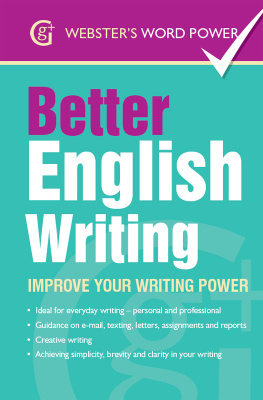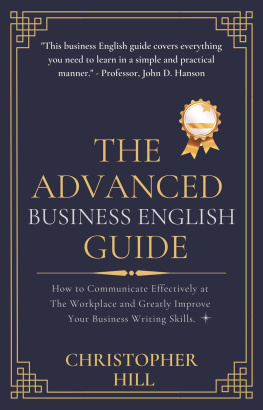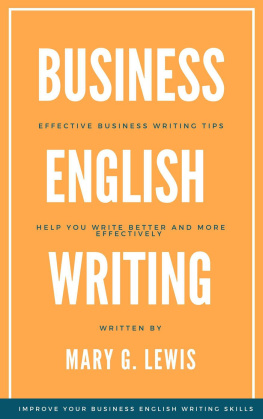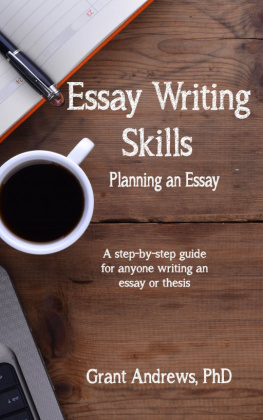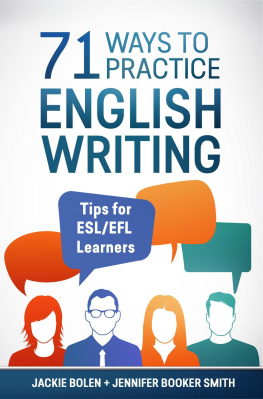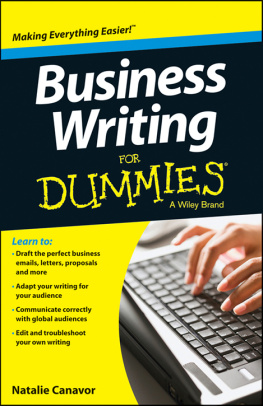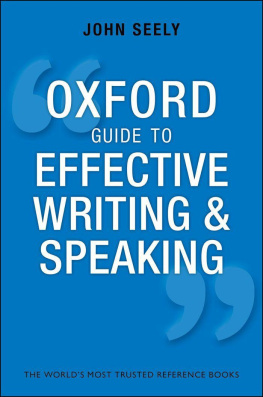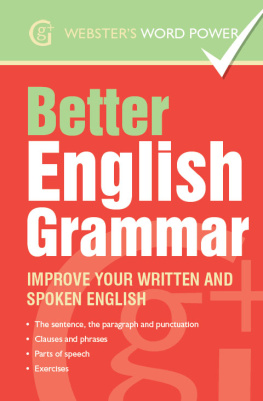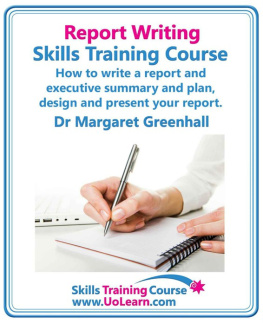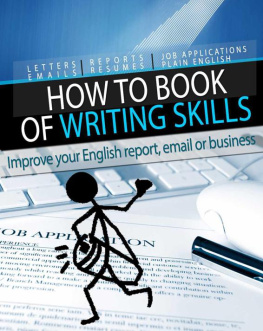

BETTER ENGLISH WRITING
The aim of this book is to help you write clearer and more concise English whether you are writing emails or writing a thesis.
By the time you have finished this book, you will have learned tips and techniques to improve your written English and make it more readable and interesting. You will be able to write clearly and effectively, and to come across in a memorable and professional way.
The book contains six main chapters. These are as follows.
Better writing for every day
This chapter gives you some general advice to help you write better English whatever that type of writing is. It covers the importance of plain English, and will help you to apply the principles of plain English to your writing. We have provided some examples of how not-so-plain English can be converted into plain English!
We also focus on the importance of editing and revising your writing in this chapter. Even the most professional and gifted of writers edit and revise their work.
Writing for learning
In this chapter the focus is on writing for learning. You will find out about research and how to tackle writing essays and theses. There are examples of each of these to give you an idea of what is expected.
You can apply this information to writing assignments for all sorts of courses whether you are at school, college, university or doing a distance learning course.
Writing for work or business
This chapter gives you the advice and support you need to be able to tackle all sorts of writing for work or business from writing a CV or making a presentation to get the job, through to communicating with customers by email, letter or text.
There are examples of each type of writing.
Writing for the media
Writing for the media involves learning specific writing techniques. If you are interested in writing articles or news items for newspapers, magazines, ezines, websites, TV or radio, then this chapter will help you to understand and apply these techniques.
It also looks at interview techniques and house styles, and provides useful examples.
Writing creatively
This chapter provides an introduction to the different types of fiction and non-fiction writing, and their characteristics. It also gives you advice on composition techniques that you can apply to your own fiction and non-fiction writing.
Again, examples are provided to illustrate these techniques.
Keep reading and writing!
One of the best ways to improve your own writing is by reading other peoples writing. In this chapter, we leave you with some suggestions for material that you should read every day. We also have some suggestions for how you can practise writing regularly the more you write, the better youll get.
We hope that you enjoy using this book, and that it will inspire you to produce clear, concise and memorable writing!

In this chapter, we are going to look at what we mean by plain English and why it is so important. We will then discuss the principles of plain English, and how to apply these to everything you write, whether its a letter, an email, a marketing brochure or a dissertation.
There are a number of examples to show how not-so-plain English can be transformed into plain English. It really does make a huge difference when you can read and understand something easily the first time round.
Finally, there is a section on the importance of editing and revising your writing, and the role of AutoCorrect, spellcheckers, grammar checkers and Google Translate in this process.
In this section we are going to look at what we mean by plain English.
Plain English writing always keeps the reader in mind, so it is clear and concise and uses the appropriate tone.
Some people think that plain English is oversimplified and that it talks down to readers, as if they were children.
Some people think that writing good English means writing long, convoluted sentences, with lots of clauses, which have, or try to have, impressive, indecipherable words, with regard to making lots of grandiose points in a pompous and grandiloquent way and it would seem not really going anywhere with them at all and, quite frankly, leaving the reader confounded, disconcerted and bewildered, and not understanding at all what the sentence is about because regarding this they go and on and dont seem to know when to stop and in order to get to the end of the sentence the reader has to read the sentence over several times and endeavour hard to understand it, which is quite egregious, dont you agree?
Confused? You should be. This sentence shows why plain English is so important.
Think about why we write in the first place. We write to communicate a message to our reader not to show how clever or educated or well-read we are. If we cant communicate our message to the reader in a way that they understand then whats the point? We are excluding them, rather than including them.
And apart from anything else, plain English is faster to write and faster to read. People understand your message more easily and respond more positively if it is written using a straightforward and friendly tone, rather than a stuffy and bureaucratic one.
Here are some plain English principles. Apply these to your writing and notice the difference. It can take a while to retrain yourself to write this way, but its well worth the effort.
Ask yourself the following questions before you start to write. If you do this, then you are more likely to produce a well-structured and effective piece of work. If you dont, then your writing is more likely to ramble on, go off at a tangent and not make sense because you dont really know what you want to say.
What do I want this piece of writing to do?
What are its aims and outcomes?
Who are my readers?
What do I want them to learn/know?
What do they need/want to learn/know?
What is the simplest and most effective way of passing on this information?
Make a plan of the structure of your work. How you do this is up to you. Some people think of their piece of writing as a story, and write out main headings and subheadings. Some people make out a list of points, in a logical order. Some people use mind maps. Use a method that you feel comfortable with.
For example, look at the contents page of this book. The writer used this as a plan for the structure of the book.
Writing doesnt have to be formal and intimidating. You wouldnt speak to your reader that way, so you dont need to write that way. Try to address your reader personally, and call them you it will make your writing seem less bureaucratic and intimidating.
Heres an example. If you were applying for a job, which of the following would you prefer to read?
It is suggested that job applicants submit a handwritten form and hand it in prior to the interview. Applicants will be notified by telephone of their success or otherwise.
or
Please fill in your job application form and hand it in before the interview. We will phone you to let you know if you have been successful.
In the same way, you should also use we or I if you are talking about your business or organisation. It gives a much more direct and positive tone to your writing.
People sometimes make the mistake of thinking that by using simple, straightforward words, you are patronising your reader. Quite the opposite if were honest, we all prefer to read clear and straightforward text rather than difficult, convoluted text.
Next page
